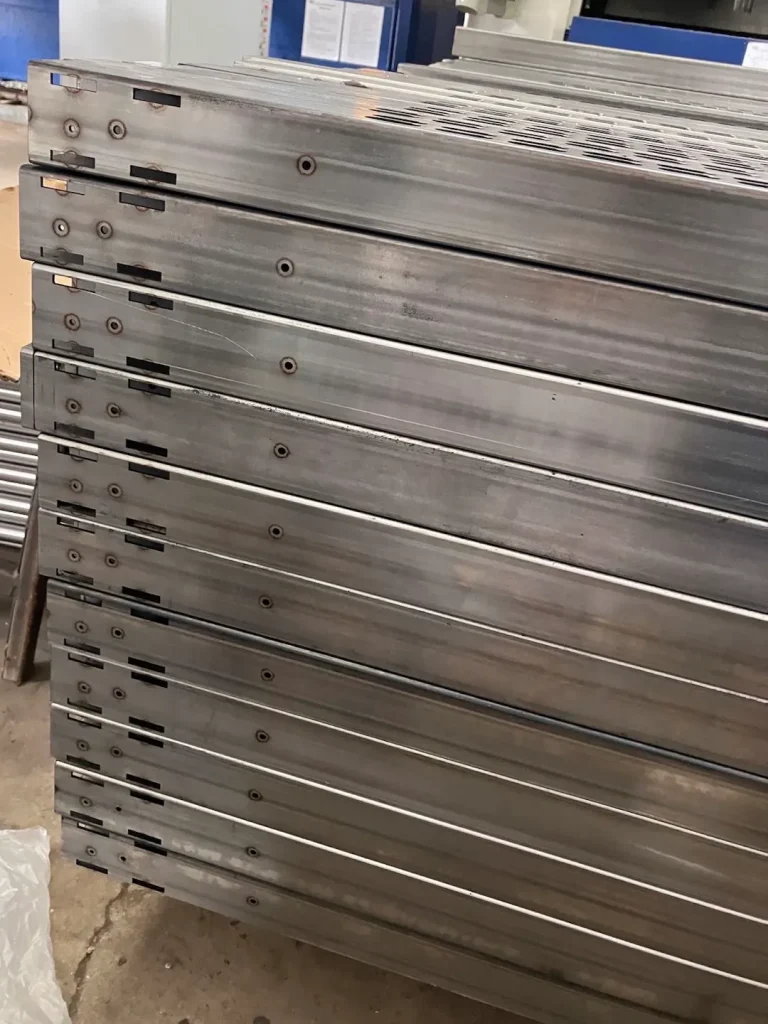目次
概要 & 使用例
Able Hardware provides production-grade fiber laser cutting for both sheet/plate and tube, integrated with forming, 機械加工, 溶接, 仕上げ, and export packaging. For OEM/ODM buyers, our laser cells deliver fast prototyping and repeatable volume runs with clean edges and stable dimensions ready for downstream assembly カスタムメタルフレーム そして 自動溶接.
Why this solution for precision, speed & cost control
Fiber lasers cut most engineering metals quickly with minimal heat-affected zone (HAZ). Assisted gases (N₂/O₂/Air) and optimized nesting reduce scrap; micro-joints そして etch marking keep kits intact and traceable. Typical cut accuracy ±0.10–0.20 mm with kerf ≈0.10–0.30 mm helps engineers hit assembly stack-ups without costly secondary machining.
Typical industries & applications
- Industrial equipment & machinery: base plates, guards, brackets, service panels.
- Warehouse/logistics: gussets and panels for carts/racks (see /products/welding-trolley-carts/).
- Robotics & automation: riser plates, cell panels, lightening patterns that bend cleanly.
- HVAC/electrical: enclosure plates, perforated doors, busbar covers.
- Automotive/agricultural: skid plates, tabs, chassis brackets ready for fixture welding.
技術的特性
材料, thickness ranges, kerf & 公差 (ISO 9013/ISO 2768)
- Carbon steel: Q235/S235, Q355/S355, 0.8–25 mm
- ステンレス: 304/316, 0.8–20 mm
- アルミニウム: 5052/6061/6082, 0.8–15 mm
- Galvanized steel: per coating class; edge quality verified post-cut
- Bed sizes: 1250×2500, 1500×3000, 2000×4000 mm
- Dimensional: 通常 ±0.10–0.20 mm (feature/geometry dependent) under ISO 2768-m/f
- Cut quality: ISO 9013 range 2–4 (specify per material/thickness)
- Kerf: ≈0.10–0.30 mm used for nesting and compensation
制限事項 & design-for-laser guidelines (min holes/slots, radii)
- Min hole Ø ≈ 1.0–1.2× material thickness
- Min slot width ≈ material thickness + 0.2 んん
- Inside corners: add small fillets to reduce heat dwell and burr
- Tabs/bridges: sized per thickness to hold parts in sheet; removed in deburr
- Common-line cutting: permitted on compatible features to reduce burr/heat
- Etch marking: add shallow alphanumeric/part IDs for kitting (avoids labels during processing)
製造オプション
Cutting gases (N₂/O₂/Air), nesting & micro-joints; deburr, tap, countersink
- Assist gas:
- N₂ for stainless/aluminum cosmetic edges
- O₂ for thicker carbon steel throughput
- Air for cost-optimized runs (confirm edge spec)
- Nesting: yield-optimized layouts with kerf compensation そして micro-joints for kit stability
- Post-cut prep: deburr/chamfer, countersink, tapping (M3–M12 typical), re-aming of precision holes
二次作戦: 曲げ・成形, 機械加工, 溶接; コーティング & パッケージング
- 形にする: press-brake bending with bend deduction tables; flat-to-form workflows
- CNC加工: critical bores/faces when GD&T requires tighter than laser spec
- 溶接: manual/robotic MIG (TIG if specified) に ISO 13920 紀元前 with ISO 5817 Class C default (Class b for visible joints), そして ISO 2553 weld symbols; see /services/automatic-welding/
- 仕上げ: パウダーコート (RAL, 70–100 µm), 亜鉛メッキ, 電子コート, industrial paint; surface prep to ISO 8501, coating selection by environment per ISO 12944; see /services/powder-coating/
- Export packaging: pallet/crate, interleaf to protect surfaces, labeled kits with barcodes and piece counts for line-side assembly
種類 & ジオメトリ
Common part families (brackets, panels, ガセット, base plates, perforations) & sheet size bands
- Flat panels & doors (≤2000×4000 mm) with louvers/perforations
- Angle brackets & ガセット with reliefs that bend cleanly after cutting
- Base plates with slot/hole patterns for adjustable mounting
- Perforated guards & screens with tuned open-area ratios
- Kitted blanks for frames/carts that proceed to bending/welding
品質 & テスト
私たちが検証すること (dimensional check, edge quality; DFT to ISO 2808) とドキュメント (CoC, inspection reports)
- In-process: dimensional checks vs DXF/DWG, edge burr & HAZ review, flatness sampling for large plates
- After finishing: DFT measured to ISO 2808, adhesion checks as specified
- Documents: CoC, inspection reports, material traceability and lot labels.

Fiber laser cutting steel 2 んん, N₂ assist, clean edge
価格設定 & リードタイム
Moq, sample policy, 示唆的なコスト要因 (厳しい価格はありません)
- Moq: フレキシブル; prototype lots accepted to prove fit/form/function
- Samples: quick-turn laser blanks available prior to forming/welding
- Lead time: rapid prototypes in days; production lots typically 1–3 weeks depending on forming/welding/finish queues
- Cost drivers: material grade/thickness, sheet utilization (nest yield), part count and pierces, assist gas, tolerance class, deburr level, tapped holes/countersinks, forming steps, weld length, coating type/DFT, and packaging specification
規格 & コンプライアンス
関連する規格/認証 & 提供されたドキュメント (ISO 9013, ISO 2768, ISO 13920, ISO 2553, ISO 5817, ISO 12944, ISO 8501)
- Cut quality: ISO 9013
- General tolerances: ISO 2768-m/f
- Weld fabrication: ISO 13920 紀元前, ISO 2553 symbols
- Weld acceptance: ISO 5817 (Class C standard, Class B for visible joints)
- コーティング: ISO 12944 (environmental category) and surface prep ISO 8501
- Full inspection/traceability package available on request.
よくある質問
What metals and grades do you cut?
Q235/S235, Q355/S355, 304/316 stainless, 5052/6061/6082 アルミニウム, and galvanized steel. Specify finish condition (例えば。, 2b, brushed) if cosmetic.
What thickness limits apply?
Typical ranges: steel 0.8–25 mm, stainless 0.8–20 mm, aluminum 0.8–15 mm. We’ll confirm cut quality class (ISO 9013 2–4) by material and thickness.
What tolerances should I call out?
Use ISO 2768-m/f for non-critical features; specify GD&T for critical bores/faces. As-cut accuracy is commonly ±0.10–0.20 mm with kerf ≈0.10–0.30 mm.
Any design rules for holes and slots?
Min hole ≈1.0–1.2× thickness; min slot ≈ thickness + 0.2 んん. Add small inside radii and avoid knife-edge features to improve edge quality and bend consistency.
Can you bend, 溶接, and coat after cutting?
Yes—forming, 機械加工, MIG/TIG welding to ISO 13920 with ISO 5817 acceptance, and powder coat/e-coat/zinc plating per ISO 12944. See /services/automatic-welding/ そして /services/powder-coating/.
What about tube laser cutting?
We cut both sheet/plate and tube profiles (slots, copes, tab-and-slot for jig-free fit-up) and can deliver welded assemblies ready for installation.
What files do you accept?
DXF/DWG for flat parts; STEP/IGES for formed/welded assemblies. Include material, 厚さ, 量, 公差, finish, and packing notes.
Upload your drawing to get a fast, engineered quote
Send DXF/DWG/STEP with quantities and finish notes. We’ll return manufacturability feedback, nest yield, and a firm schedule.